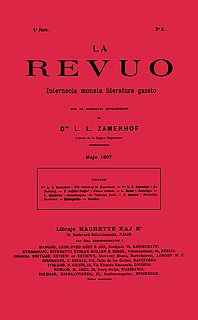
Esperanto is the world's most widely spoken constructed international auxiliary language. Created by Warsaw-based ophthalmologist L. L. Zamenhof in 1887, it was intended to be a universal second language for international communication, or "the international language". Zamenhof first described the language in Dr. Esperanto's International Language, which he published under the pseudonym Doktoro Esperanto. Early adopters of the language liked the name Esperanto and soon used it to describe his language. The word esperanto translates into English as "one who hopes".

L. L. Zamenhof developed Esperanto in the 1870s and '80s. Unua Libro, the first print discussion of the language, appeared in 1887. The number of Esperanto speakers have increased gradually since then, without much support from governments and international organizations. Its use has, in some instances, been outlawed or otherwise suppressed.

L. L. Zamenhof was an ophthalmologist who lived for most of his life in Warsaw. He is best known as the creator of Esperanto, the most widely used constructed international auxiliary language.

Dr. Esperanto's International Language, commonly referred to as Unua Libro, is an 1887 book by Polish ophthalmologist L. L. Zamenhof, in which he first introduced and described the constructed language Esperanto. First published in Russian on July 26 [O.S. July 14] 1887, the publication of Unua Libro marks the formal beginning of the Esperanto movement.

Fundamento de Esperanto is a 1905 book by L. L. Zamenhof, in which the author explains the basic grammar rules and vocabulary that constitute the basis of the constructed language Esperanto. On August 9, 1905, it was made the only obligatory authority over the language by the Declaration of Boulogne at the first World Esperanto Congress. Much of the content of the book is a reproduction of content from Zamenhof's earlier works, particularly Unua Libro.

Dua Libro de l' Lingvo Internacia, usually referred to simply as Dua Libro, is an 1888 book by L. L. Zamenhof. It is the second book in which Zamenhof wrote about the constructed language Esperanto, following Unua Libro in 1887, and the first book to be written entirely in the language.
Vladimír von Szmurlo was a Russian Esperantist and railway engineer.
Montagu Christie Butler was a British academic, librarian, lexicographer, musician, and Esperantist. A winner of several prizes at the Royal Academy of Music in London, he was a harpist and a versatile music teacher skilled in playing various musical instruments, as well as a teacher of voice and of musical composition.
Adolf Holzhaus was an Esperantist and historian of the Esperanto movement. Between 1959 and 1985, he compiled biographies of the lives of Esperanto creator L. L. Zamenhof and his family, Esperanto pioneer Wilhelm Heinrich Trompeter, and others. He edited and published documents on the history of Esperanto, including Zamenhof's Hillelism and "Provo de gramatiko de novjuda lingvo kaj alvoko al la juda intelektularo".

Théophile Cart was a French Esperantist professor and linguist.

Leopold Einstein was a Jewish teacher, vendor, and writer. He was one of the early proponents of Esperanto.
An Esperanto club is a club of Esperanto speakers, or Esperantists. In contrast to national or international Esperanto organizations, an Esperanto club usually limits its activities only to a certain city or region. Esperanto clubs have been forming the backbone of the Esperanto movement since the beginning of the movement, although recently the situation is starting to change due to the possibility of immediate and first-hand communication that is provided by the Internet.

The World Esperantist Vegetarian Association is a voluntary association of Esperanto-speaking vegetarians. Founded in 1908, the group's working language is Esperanto, and it is the oldest international organization of vegetarians that is currently active. TEVA published a journal, Vegetarano ("Vegetarian") from 1914 to 1932, revived in 2009 as Esperantista Vegetarano, and has also operated a spirited Internet mailing list through Yahoo! Groups since 2005.
Medicina Internacia Revuo is the official organ of Universala Medicina Esperanto Asocio, an organization that gathers physicians, pharmacists, and other medical professionals who have a working knowledge of Esperanto. The twice-yearly journal publishes articles that have undergone peer review and that are written in various languages, including English and Polish; abstracts are provided in English and Esperanto. The journal publishes broadly within the medical sciences, has an internationally renowned board of editors, and is included in the Index Copernicus database. The journal is available gold open access, but no author fees are charged.

Isaj Dratwer was a Polish Jewish bacteriologist and esperantist. In the Esperanto movement, Dratwer was a strong advocate, President of the Esperanto Academy, and committee secretary in 1927 and 1931. He often published articles or letters in the Heroldo de Esperanto, Pola Esperantisto and others. He also translated Russian-language novels by Romanov in 1932.

Lingvo Internacia was an Esperanto periodical, published from 1895 to 1914. It was the second Esperanto periodical, following La Esperantisto (1889–1895). Lingvo Internacia was the central Esperanto publication in the years leading up to World War I, accompanied by La Revuo (1906–1914).
Lingvo internacia means international language in Esperanto. It may refer to:

La Revuo: Internacia monata literatura gazeto was an Esperanto periodical, published from 1906 to 1914. It was the third Esperanto periodical, following La Esperantisto (1889–1895) and Lingvo Internacia (1895–1914). Together with Lingvo Internacia, La Revuo was one of the two central Esperanto publications leading up to World War I.

The following outline is provided as an overview of and topical guide to Esperanto:













